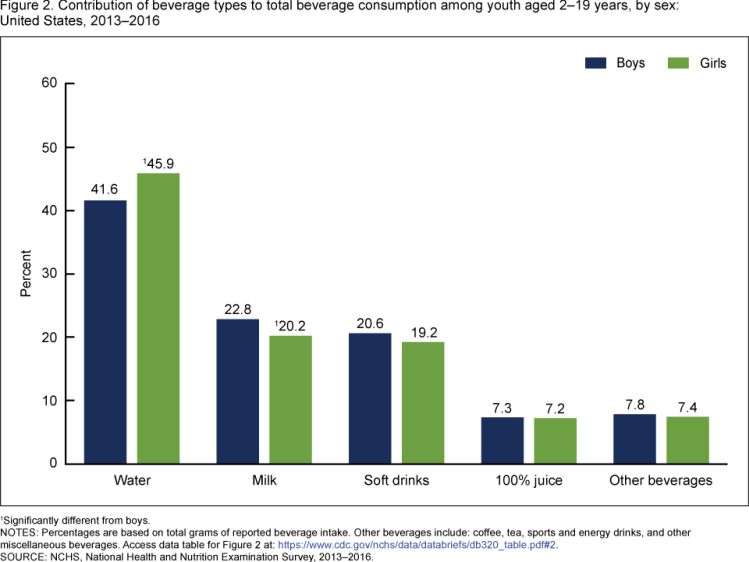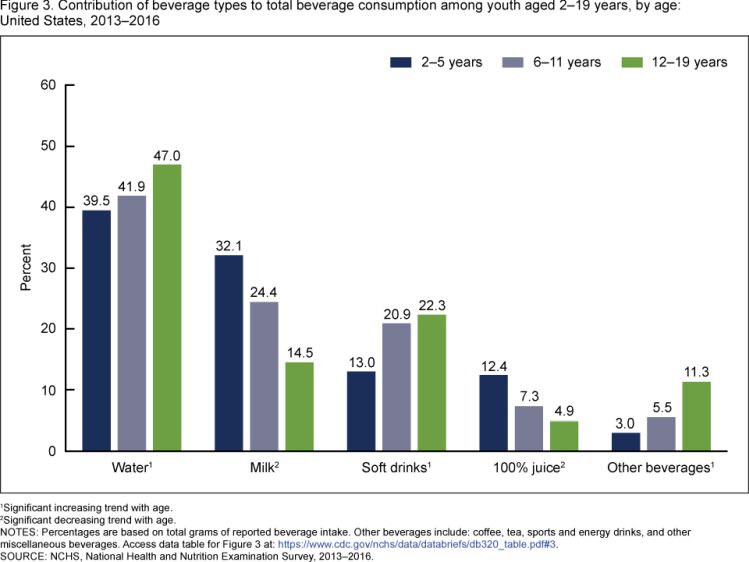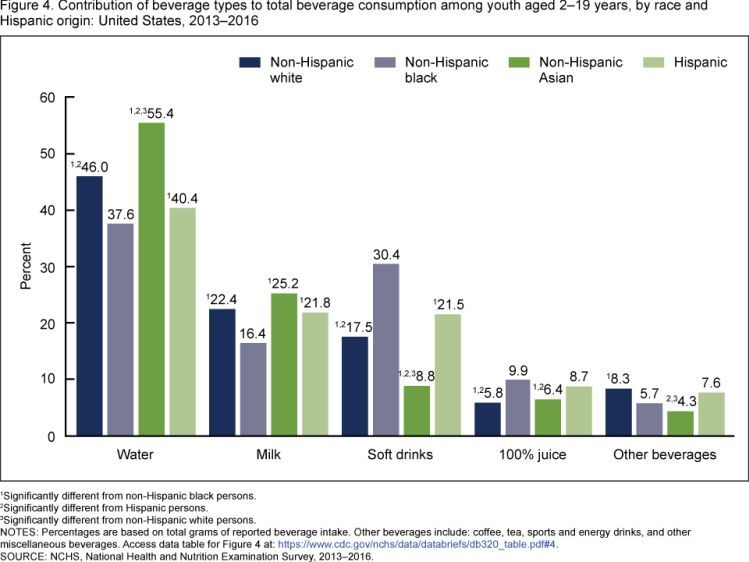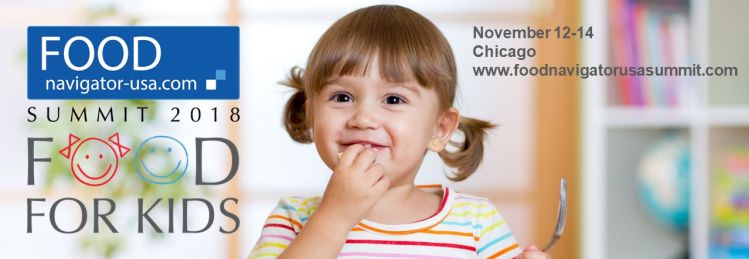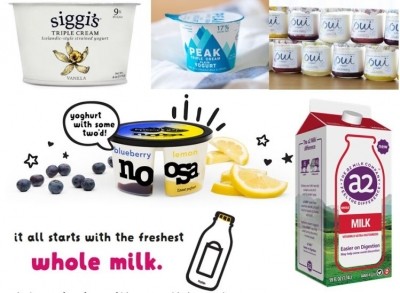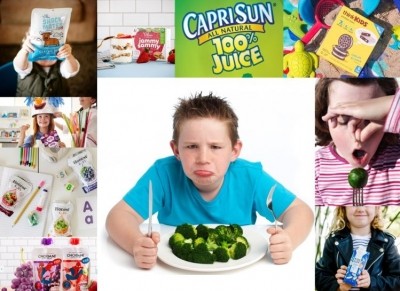Children are drinking less milk and juice as they get older... But what are they drinking instead?

‘Other beverages’ such as coffee, tea, sports, energy drinks, and miscellaneous other products accounted for 7.6% of intakes.
As in previous data sets, consumption of milk dropped significantly with age, with milk accounting for almost a third of beverage intake (32.1%) for 2-5 year olds, but dropping to just 14.5% for 12-19 year olds during the period.
A similar trajectory applied to 100% juice, which accounted for 12.4% of beverage intakes for 2-5year olds, but just 4.9% for 12-19 year olds.
As kids grow older, they are ditching milk and juice for water, soft drinks, coffee, tea, and energy drinks
So what are kids replacing milk and juice with?
As children move into the 6-11 year bracket, consumption of soft drinks rises the most strongly, while consumption of water and other beverages (energy drinks, coffee etc) rises as they hit the 12-19 year bracket.
Gender: Girls drink more water and less milk than boys
There are some differences in consumption habits based on gender, with girls drinking significantly more water, and slightly less milk and fewer soft drinks, than boys.
African Americans drink more soda, less water and milk, than other groups
However, the sharpest differences in beverage choices are based on ethnicity, with African American kids consuming significantly more soft drinks, slightly more juice, and significantly less water and milk than all other population groups, with 30.4% of their intakes derived from soft drinks compared to just 8.8% for non-Hispanic Asians, 17.5% for non-Hispanic whites, and 21.5% for Hispanics.
Asian children, meanwhile, consumed the most water (55.4% of intakes), the most milk (25.2%), and the lowest levels of soft drinks (8.8%).
National Dairy Council: Decreased milk consumption with age is associated with lower consumption of under-consumed nutrients of public health concern
So what's the biggest takeaway from all this?
Dr. Chris Cifelli, VP of nutrition research at the National Dairy Council, told FoodNavigator-USA that beverages provide a substantial percentage of overall energy intakes, and can be a big source of empty calories if children (and/or their parents) don't make wise choices.
"Decreased consumption of nutrient-rich beverages, such as milk [a leading food source of nine essential nutrients for kids], with age is associated with lower consumption of under-consumed nutrients of public health concern," he added.
"For all Americans aged two years and older, milk is the number one food source of three of the four under-consumed nutrients of public health concern identified by the 2015-2020 Dietary Guidelines for Americans, namely calcium, vitamin D and potassium."
As for the differences between beverage consumption habits based on ethnicity, he said: "Our own recently published study showed that Non-Hispanic Black young children drank the most 100% juice from two to three years and up, exceeding recommended amounts, and throughout all age groups they drank the least milk and most sugar sweetened beverages."
Schools are in a unique position to impact children’s beverage choices
Linn Steward, RDN, noted that, multiple studies have "demonstrated that communities of color have been targeted by advertising that reinforces cultural and social acceptance of sugar sweetened beverages. Some communities are better prepared to counter the impact of this type of advertising than other communities. Personally I favor banning all advertising to young children regardless of what community they live in."
And while parents bear much of the responsibility for kids' beverage choices, she added: "Schools are in a unique position to impact children’s food choices because many rely on school meals as their major source of nourishment. Since 2012, schools could only offer fat-free, including non-fat chocolate milk, and low-fat unflavored fluid milk to qualify for federal reimbursement.
"Given current controversies on the healthfulness of dairy fat, I would be in favor of re-evaluating whole milk for school meals, and I part company with my professional organization the Academy of Nutrition and Dietetics [which recommends low fat milk] on this matter. Whole milk is judged by most to be more palatable and offering more choice is likely to increase milk consumption."
But there is good news in the figures, she said: "Water is the beverage of choice among youth and that’s good news. Milk is the second choice and that’s also good news. Bone health is important for both young men and women, but there are good non-dairy options available [which are often fortified with calcium and vitamin D] so I’m not concerned that young women drink less than young men as long as educational resources are available to help young women identify good non-dairy options for ensuring healthy bones."
Is water displacing soft drinks, or nutrient dense fruit and dairy beverages?
Jenna Bell, PhD, RD, SVP, director of food & wellness, at Pollock Communications, noted that when beverage intakes are assessed in isolation, "you cannot draw conclusions about total diet vitamin and mineral intake, calories or sugar."
That said, "when soft drinks represent the greatest proportion, the intake of empty calories is a concern."
As far as increases of water intake are concerned, she said, "I only see it as a positive move if it coincides with a significant reduction in soft drink consumption. If water is primarily displacing nutrient dense fruit and dairy beverages, or if it’s on the rise because of bottled water purchases, I see pros and cons to the increase."
Catherine Adams Hutt, PhD, RD, principal at consultancy RdR Solutions, agreed, adding: "Water consumption is good for hydration and is non-caloric, but does it crowd out consumption of other more nutrient dense beverages as children age?
"What I think is interesting is nutrient density and consumption of shortfall nutrients, specifically potassium, calcium, and vitamin D. 100% juice can be an excellent source of potassium, but it depends on what the juice is - for example, orange juice has about twice as much potassium as apple juice."
*Click HERE to see the figures, released from the Centers for Disease Control and Prevention (CDC), based on an analysis of data from the National Health and Nutrition Examination Survey (NHANES) dietary intake survey for 2013-2016.
The ‘water’ category included unsweetened bottled and tap water, carbonated and still. Milk included dairy milk substitutes such as soymilk and almondmilk. Soft drinks, both diet and non-diet forms, included soda and fruit drinks (including sweetened bottled waters and fruit nectars). 100% juices included fruit and vegetable juices with no added sugar. Other beverages included coffee, tea, sports and energy drinks, and other miscellaneous beverages not included in the groups above. Alcoholic beverages were not included.
Estimates represent a ratio of the grams of each beverage type divided by the total grams of all included beverages, multiplied by 100.
- Join the conversation at our panel debate on day three of the FoodNavigator-USA FOOD FOR KIDS summit in Chicago Nov 12-14, which will explore what kids are drinking and how the industry can help them make better - but delicious - choices.
